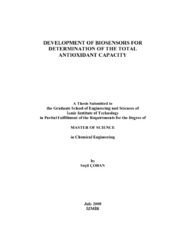Please use this identifier to cite or link to this item:
https://hdl.handle.net/11147/4038Full metadata record
| DC Field | Value | Language |
|---|---|---|
| dc.contributor.advisor | Bayraktar, Oğuz | - |
| dc.contributor.author | Çoban, Seçil | - |
| dc.date.accessioned | 2014-07-22T13:53:03Z | - |
| dc.date.available | 2014-07-22T13:53:03Z | - |
| dc.date.issued | 2008 | - |
| dc.identifier.uri | http://hdl.handle.net/11147/4038 | - |
| dc.description | Thesis (Master)--Izmir Institute of Technology, Chemical Engineering, Izmir, 2008 | en_US |
| dc.description | Includes bibliographical references (leaves: 116-122) | en_US |
| dc.description | Text in English;Abstract: Turkish and English | en_US |
| dc.description | xiii, 133 leaves | en_US |
| dc.description.abstract | In this study, an amperometric laccase biosensor was developed for determination of the oleuropein concentration that is the biological active component of olive leaf and contributes dominantly to the total antioxidant capacity. The biosensor was prepared by immobilization of laccase from Trametes versicolor by addition of cross-linking agent, glutaraldehyde, into the carbon paste electrode. Different biosensors were prepared by changing the amount of crosslinking agent and concentration of the enzyme solution. So, effect of these parameters on biosensor performance was investigated. The best biosensor performance was determined for the biosensor having glutaraldehyde amount of 12.03 % vol. of the biosensor bottom part and 5 mg/ml of laccase enzyme. The effect of scan rate and temperature on the biosensor performance was also investigated in this study. The scan rate of 10 mV/s was decided to be the optimum for the amperometric detection of oleuropein considering the fastest response and maximum reduction current. 250C was chosen as an optimum temperature value due to the maximum laccase activity and capability of oleuropein acting as an antioxidant. Extraction of phenolics from olive leaf was also an important part of this study. The extract was divided into fractions varying in their oleuropein amounts such as polar fractions and relatively less polar fractions. Therefore, biosensor performance was investigated for fractions containing different type of phenolics. HPLC analyses of the fractions were also performed in this study. In addition total phenol content and antioxidant capacity of the fractions were determined by conventional methods. | en_US |
| dc.language.iso | en | en_US |
| dc.publisher | Izmir Institute of Technology | en_US |
| dc.rights | info:eu-repo/semantics/openAccess | en_US |
| dc.subject.lcc | TP159.C46 C652 2008 | en |
| dc.subject.lcsh | Biosensors | en |
| dc.subject.lcsh | Chemical dedectors | en |
| dc.subject.lcsh | Calibration | en |
| dc.subject.lcsh | Antioxidants | en |
| dc.title | Development of Biosensors for Determination of the Total Antioxidant Capacity | en_US |
| dc.type | Master Thesis | en_US |
| dc.institutionauthor | Çoban, Seçil | - |
| dc.department | Thesis (Master)--İzmir Institute of Technology, Chemical Engineering | en_US |
| dc.relation.publicationcategory | Tez | en_US |
| dc.identifier.wosquality | N/A | - |
| dc.identifier.scopusquality | N/A | - |
| item.languageiso639-1 | en | - |
| item.openairecristype | http://purl.org/coar/resource_type/c_18cf | - |
| item.fulltext | With Fulltext | - |
| item.cerifentitytype | Publications | - |
| item.openairetype | Master Thesis | - |
| item.grantfulltext | open | - |
| Appears in Collections: | Master Degree / Yüksek Lisans Tezleri | |
Files in This Item:
| File | Description | Size | Format | |
|---|---|---|---|---|
| T000737.pdf | MasterThesis | 1.03 MB | Adobe PDF |  View/Open |
CORE Recommender
Page view(s)
228
checked on Jun 2, 2025
Download(s)
114
checked on Jun 2, 2025
Google ScholarTM
Check
Items in GCRIS Repository are protected by copyright, with all rights reserved, unless otherwise indicated.